It is not often a bench power supply comes along that is unique compared to the options already on the market. In this Workbench Wednesdays video, James shows what makes the 30 Watt Triple-Output DPS3340 from Digilent uniquely interesting.
The DPS3340 has three output channels with variable voltage. Channel 1 provides up to +5 volts and up to 3 amps. Channels 2 and 3 are bipolar. Channel 2 goes to -15 volts, with channel 3 going to +15 volts. Each of those channels supplies up to 500 milliamps.
The compact unit measures only 23.40 cm x 19.40 cm x 3.81 cm and weighs just over one kilogram with the external brick supply. Within that small package, it can output up to 30 watts. However, because all three channels share a common ground, it only provides 15 Watts on C1 and 7.5 Watts on Channels 2 and 3.

Since the DPS3340 is USB-based, you need a computer running Digilent’s excellent Waveforms software. (Note from James: Waveforms continues to be my favorite all-in-one measurement platform!) Inside the Supplies (or SuppliesPS) instrument, you can independently control each output’s state, maximum voltage, current limit, and protection settings. You can also enable tracking of channels 2 and 3.
By default, there is a strip chart showing each channel's voltage and current values with a configurable history.

While you can use the DPS3340 standalone, it integrates very well with Digilent’s other Analog Discovery tools. For example, it is the same form factor as the Analog Discovery Pro 3000 series. Since the Waveforms software ties the devices together, it works just as well with the Analog Discovery 2 and Analog Discovery 3.
Performance: Peak-to-Peak Noise
After going through the basic features, James measures its performance, starting with the peak-to-peak noise. You might also know this noise as ripple voltage or periodic and random deviations (PARD). It is how much the output varies from the nominal DC value.

For this test, James started with a 470 (well 466) ohm resistor connected directly to channel 1’s output. At 5 volts, this should draw 10.7 milliamps. Even though the oscilloscope had a 20 MHz filter enabled, the result was a peak-to-peak voltage of about 35 millivolts, slightly higher than the specification from Digilent.
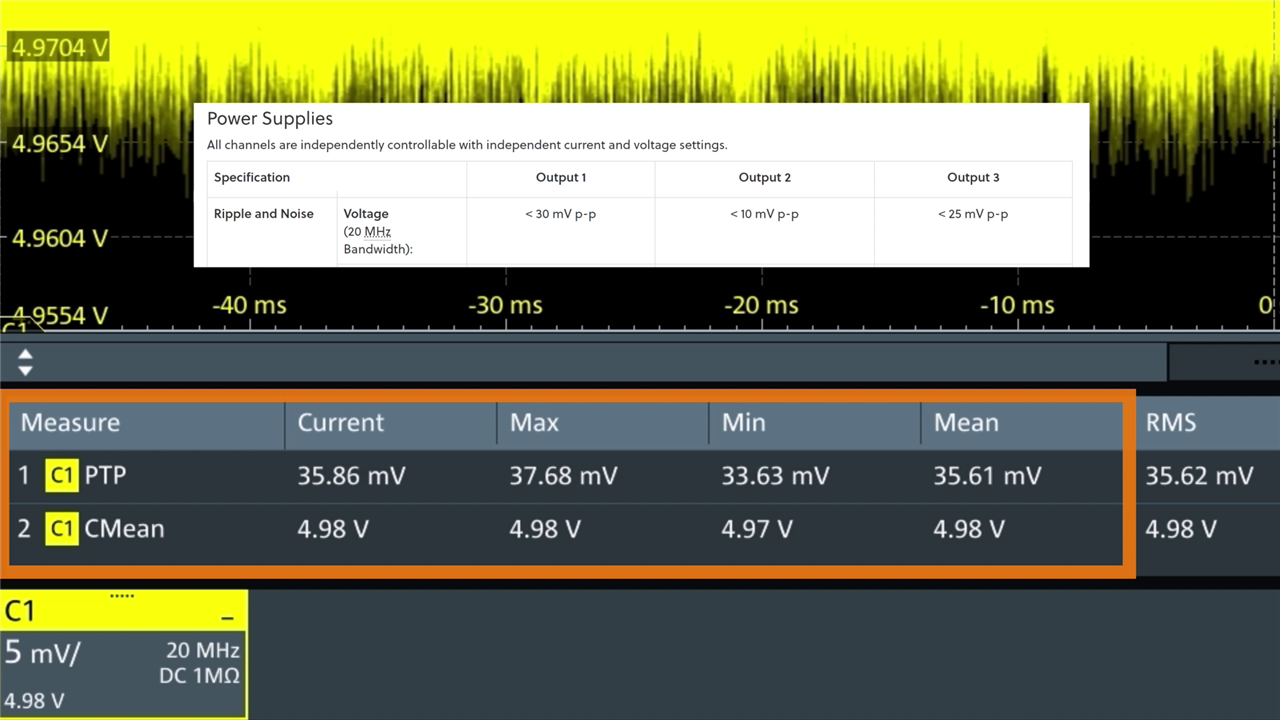
Since James did not have enough power resistors to max out the 3 amp capability, he used an electronic load instead. Setting it to 1.67 ohms should cause it to draw 2.99 amps at 5.0 volts. However, after enabling the load, James made two discoveries. First, the output current was only 2.81 amps, and the DPS3340’s own voltage meter showed its output dropped to 4.898 volts.

There are a couple of things happening.
The current is less than the expected 2.99 amps because the supply itself reduced the output voltage. The meters on the electronic load are reasonably accurate. The load’s volt meter shows 4.692 volts. The difference between the supply and load results from the ohmic losses of the cables, so this difference is expected. (And James could have used the load’s sense inputs to compensate for the drop.)
Just like in the 10.7 milliamps test, the DPS3340’s current meters were slightly lower than other instruments. (In the video, James even verifies the current draw with a 5.5-digit bench DMM!)
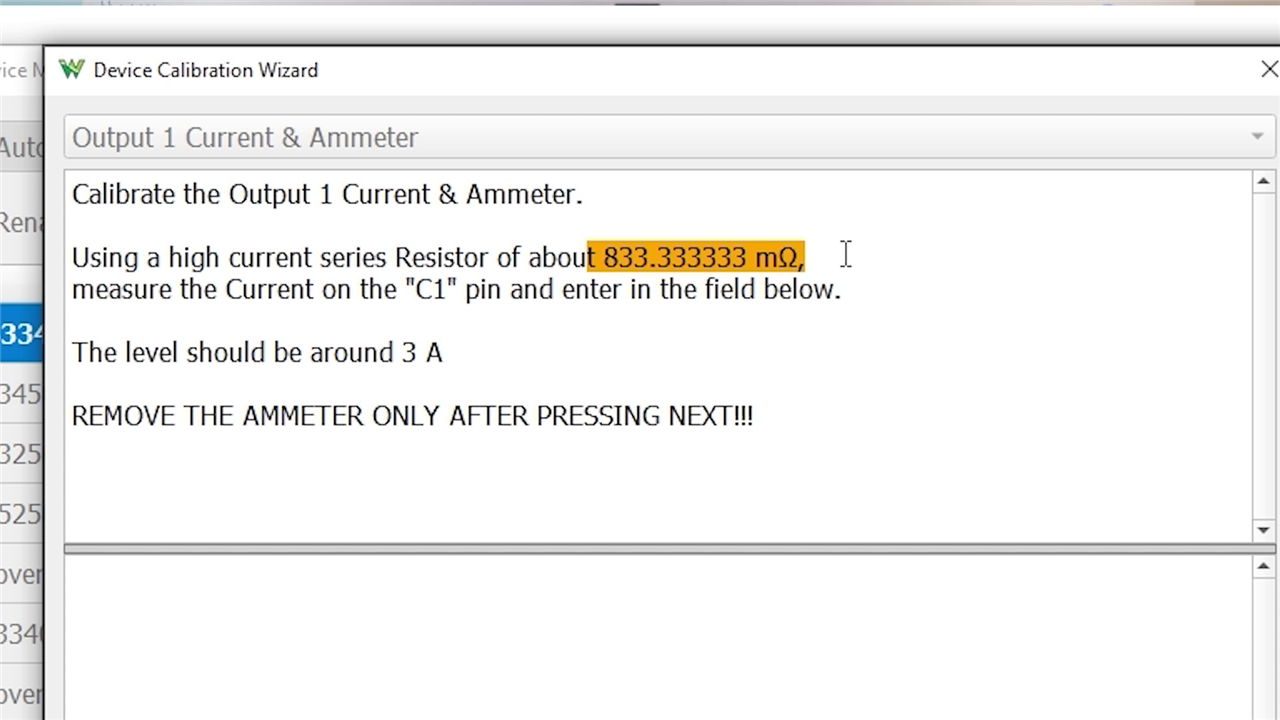
Waveforms does have a calibrate function for each power supply channel. However, to calibrate Channel 1, you need an approximate 833.333333 milliohm resistor. James does not have this particular value. (Also, James was confused by the word “about”... especially when performing a calibration step.)
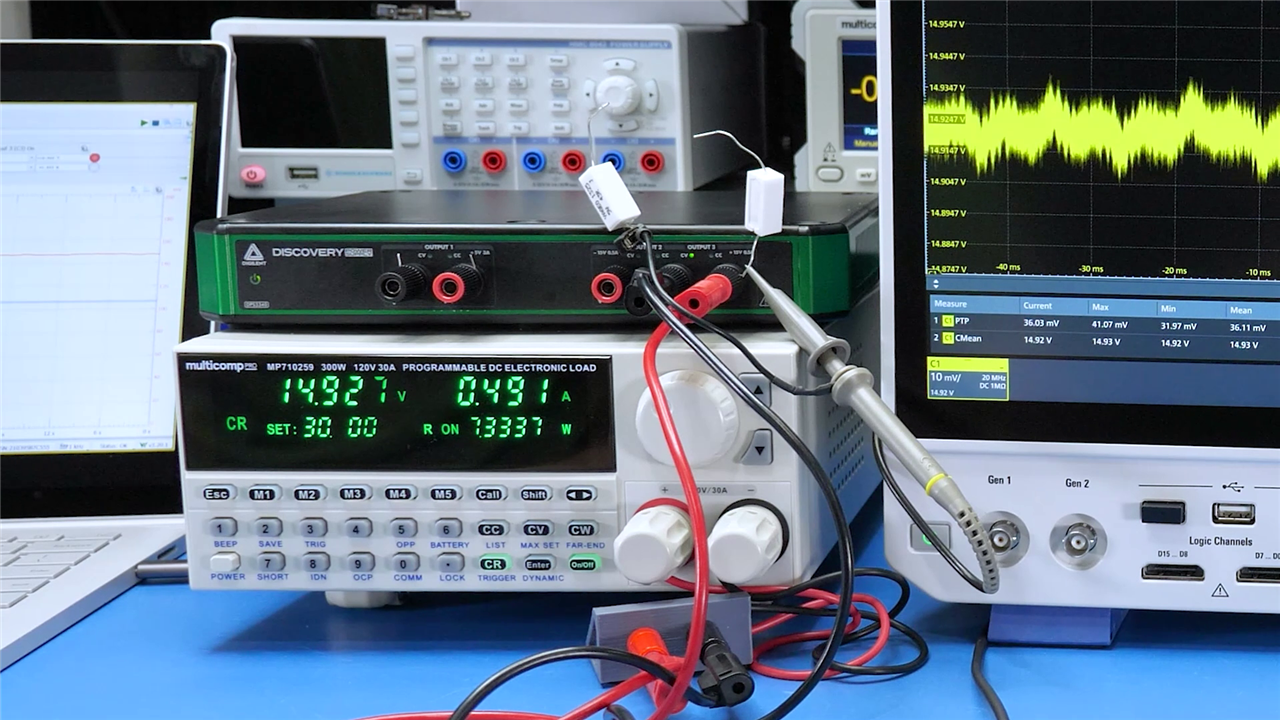
James also tested the positive 15V supply and found that at 15 volt, 490 milliamps, the output was relatively clean with a ripple of 50 millivolts peak-to-peak. Again, the values came out higher than Diglent’s specification.
But there are a couple of reasons why the measurements James made are a little high.

First he used the dreaded hook and ground wire on the scope probe for all of the captures. These are not ideal and can add some noise. Off-camera, James found using the (much better) ground-spring instead dropped all the measurements a few millivolts. (Check out the Workbench Wednesdays episode on Oscilloscope Grounds to learn why.)

The next reason is that James used a 10:1 probe. These probes divide the signal by a factor of 10, meaning the oscilloscope must amplify the signal, which adds some noise. So why use a 10:1 probe when 1:1 probes do not have this issue? Well, switchable probes, like the ones used in this video, only get 5-7 MHz of bandwidth in the 1:1 setting. And power supply measurements are typically done up to 20 MHz.
Last, another reason is that any time you measure ripple with an electronic load, it will contribute significant noise. This reason is probably why the high-current tests showed significantly more ripple than the low-current tests with resistors.
In short, while his measurements exceeded Digilent’s specifications, James does not doubt their datasheet (in this case.) There is enough grey area in how the measurements are defined and performed to explain the differences.
Additional Features
Software Fuses

In addition to constant current protection, the DPS3340 also has software-configured fuses. If a current limit is exceeded for a specified time, the supply can turn off that channel or all three. In other words, these work like a wire fuse without needing to replace anything!
James set up a small circuit for the test with two resistors and a push button. By default, the circuit draws about 10 milliamps. When the push button activates, it connects a much smaller resistor in parallel, causing the current to jump higher than 100 milliamps.
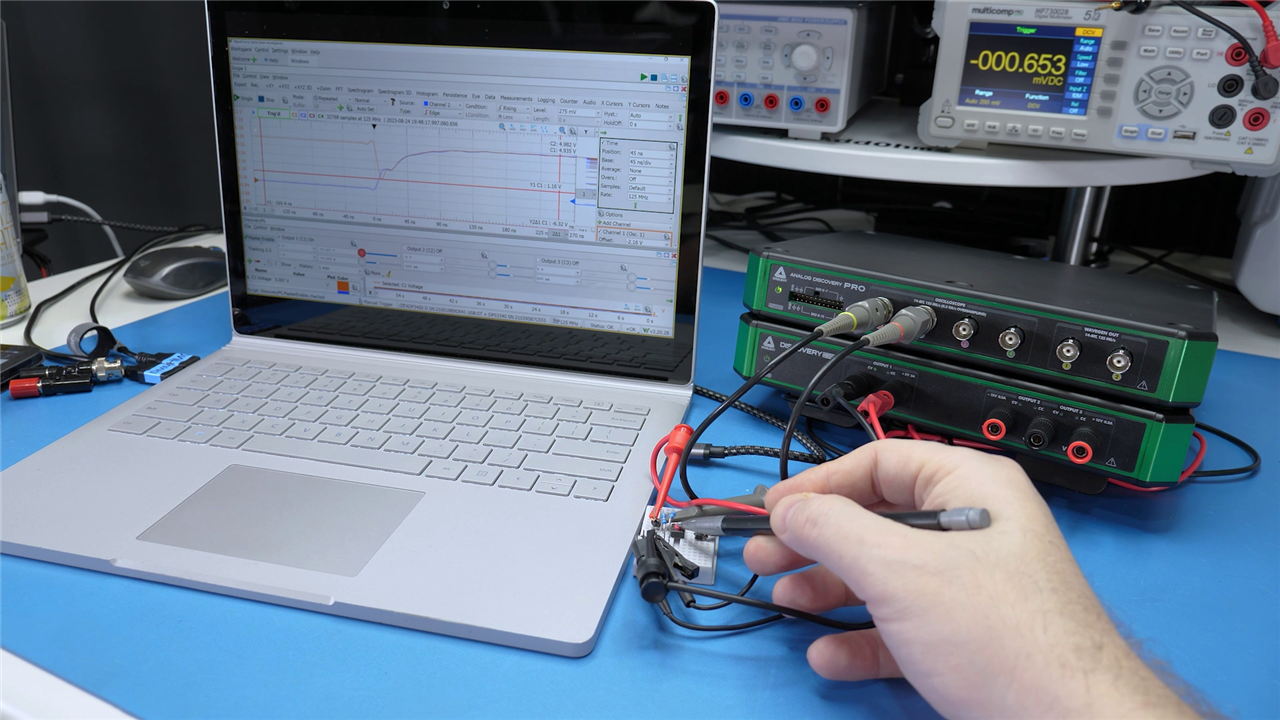
First, he demonstrated how the switch circuit operates with the default constant current protection. You can see how the supply dips briefly and then recovers. But, as expected, the channel stays on.
You can configure the current trip level and the amount of time at that level before the fuse trips. James only did one test with an immediate trip above 50 milliamps. The result was a waveform that showed the supply turning off the channel in a few hundred microseconds.

Multi-Channel Turn On

When using multiple output channels simultaneously, it is crucial to know the delay at which those channels turn on. For example, an FPGA circuit may need one rail to be stable before another. So, for the next test, James combined and connected all three channels to inputs on the Analog Discovery Pro with a banana-to-BNC adapter.
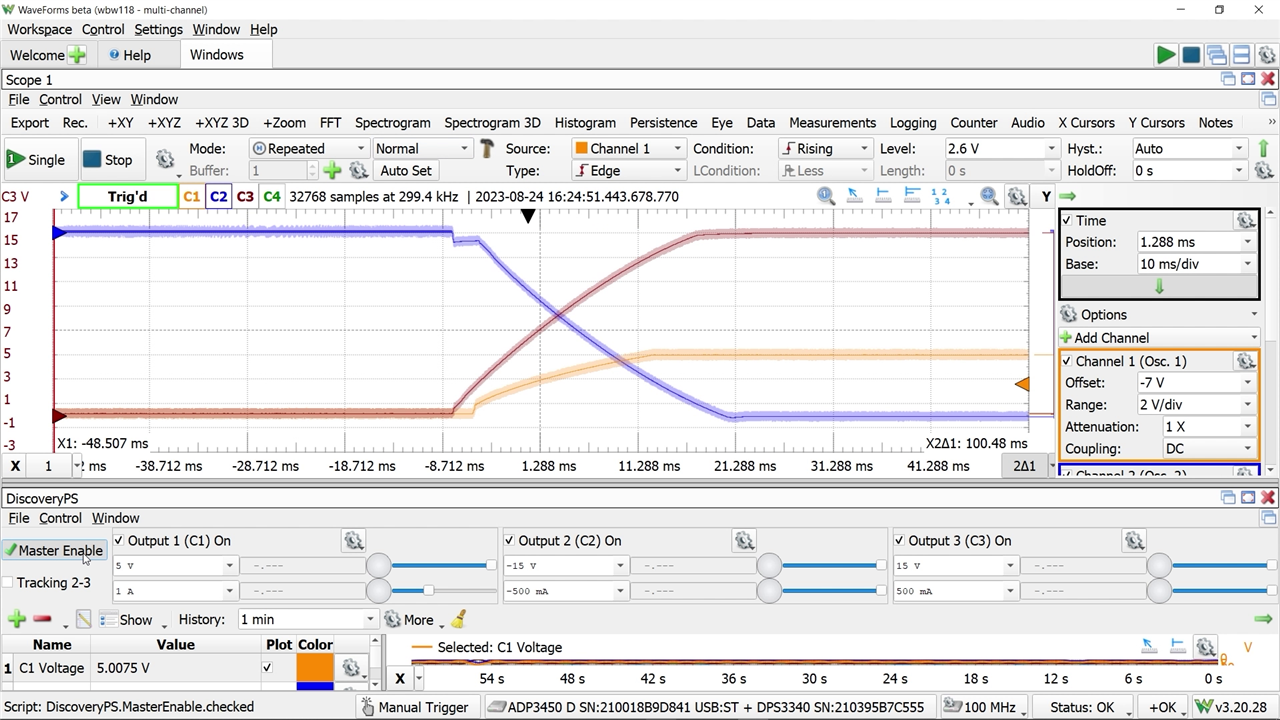
This test is an excellent example of the integration Waveforms provides. A single window contains the oscilloscope plot and the controls for the ADP3340. The plot shows that channels 2 and 3 turn off very close to each other and a few milliseconds before channel 1. James did find that adjusting the current limits could skew those results a little, but the order was usually the same.
Trade-Offs
Ground
Packing 30 watts of power output and all of these features into a small package does come with a few unexpected trade-offs. James had the most issue with the lack of floating, or isolated, outputs.

All three channels share the same ground, which is referenced to earth ground. In the above picture, the DMM shows a short between the ground of the oscilloscope and the negative terminal on the DPS3340! (Usually, bench power supplies would measure this as an open.) There are two reasons this can be an issue.
For example, since the supplies are not floating, you can not put them in series with each other (or other supplies.) Another reason is when testing with instruments like an oscilloscope. If the probe’s ground lead accidentally touches a voltage source, you will have a short circuit!
Is this a huge issue? Maybe not, since you likely ground the tools together when making measurements. But, it is something to be aware of since most laboratory bench power supplies are floating.
(Note from James: In this case, the supply IS isolated from AC mains through the transformer in the external power supply. So the concern is not a dangerous voltage being present on the output.)

External Triggers
Some power supplies provide digital inputs (and sometimes outputs) to let other equipment control the state of the supply’s outputs. The DPS3340 does not have this feature natively. However, James shows how you can use the digital inputs of an Analog Discovery and some Javascript code in Waveforms to get this behavior.

This scripting capability is one of the advantages of using the ADP3340 with other Analog Discovery tools and the Waveforms software. (Although, having triggers built into the DiscoveryPS software instrument would be nice too!)
Conclusion
The DPS3340 is an interesting choice if 30 watts of power is enough for your applications. James suggests that anyone using other analog discovery tools already would significantly benefit from the integration that Waveforms provides.
That is what James thought, what do you think of the Digilent DPS3340?
Bonus Content:
- Workbench Wednesdays 76: Checking Out Digilent's Analog Discovery
- Exploring the Digilent Analog Discovery 3000 Pro Series - Workbench Wednesdays 48
- Digilent Analog Discovery 2 Review -- Workbench Wednesdays 18
Bill of Material:
| Product Name | Manufacturer | Quantity | Buy Kit |
|---|---|---|---|
| Bench Power Supply, Adjustable, 3 Output, 1 V, 15 V, 10 mA, 500 mA | Digilent | 1 | Buy Now |
| [Base] Analog Discovery 2 USB Oscilloscope, 2 Analogue, 30 MHz, 100 MSPS | Digilent | 1 | Buy Now |
| [Base] Analog Discovery 3 Series, 2 Channel, 30 MHz, 125 MSPS | Digilent | 1 | Buy Now |
| Analog Discovery Pro ADP3450 Kit - 4 Channel, with probes and minigrabbers | Digilent | 1 | Buy Now |


Top Comments